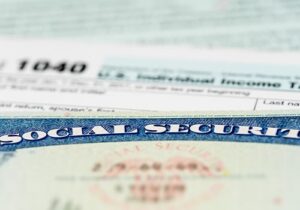Planning for retirement can be difficult, especially if you are unsure how much income you will have. Most Americans rely on Social Security for income during retirement, so predicting how much their monthly Social Security benefits will be is critical to their retirement planning. However, many people have no idea how much their Social Security payments will be. Moreover, they also have no idea how those payments are calculated.
If you need to know how much your monthly Social Security check will be, keep reading! We will tell you the average amount you can expect to receive and how the benefits are calculated. We will even give you an easy way to estimate your benefit payments. Let’s get started!
Average Social Security Check Amount
The Social Security Administration (SSA) provides millions of Americans monthly benefits, including retirement and disability benefits. The SSA also publishes data that shows the average Social Security payment amount for each type of benefit, and the data even breaks down the payments according to the type of beneficiary. Here are some details about average check amounts for both Social Security retirement benefits and Social Security disability benefits.
Social Security Retirement Benefits
The average monthly benefit for a retired worker in 2025 will be $1,976 (up from $1,927 in 2024). Remember that this is only the average amount you can expect to receive if you make average wages. Some retirees receive more than this, while others receive much less.
The maximum benefit amount that a retiree may receive in 2025 is $5,5108 (up from $4,873 in 2024), including delayed retirement credits for waiting past full retirement age to start your benefits.
Retirement benefits also include spousal benefits and survivor benefits. In January 2024, the average monthly check for spousal benefits was $905 (up from $893 in January 2023). For survivor benefits, the average payment in January 2024 was $1,503 (up from $1,448 in January 2023). You can quickly see that most people will need another source of income during retirement besides Social Security. It would be hard to live solely on these amounts.
Social Security Disability Benefits
Now that you know how much retirees can expect to receive from Social Security, let’s take a look at Social Security disability benefits. Overall, the average payments to disabled workers are slightly lower than to retirees. In 2024, the average monthly payment to a disabled worker on Social Security disability was $1,537 (up from $1,489 in 2023).
Dependent children and spouses can also be eligible for disability payments in some situations. The average payment for a dependent child of a disabled worker in January 2024 is $493 (up from $472 in January 2023), and the average payment to the spouse of a disabled worker in January 2024 is $419 (up from $407 in January 2023). These low amounts indicate the importance of signing up for private disability insurance if you cannot work.
KEY TAKEAWAYS
- Social Security benefit payments vary by the type of benefit. Retirement payments are generally the highest, followed by SSDI and SSI payments.
- You can increase your Social Security retirement benefits by earning more, working longer, and delaying the start of payments.
- Social Security retirement benefits may be subject to taxes when total combined income exceeds the income limits; up to 85% of your benefits may be taxed.
How Social Security Benefits Are Calculated
Many people wonder, “How are Social Security benefits calculated?” You probably already know you pay Social Security taxes during your working years—even on self-employment income. These taxes are placed into the Social Security trust funds and used to pay benefits to current beneficiaries. Social Security is considered a “pay as you go” system. This means that the taxes of today’s workers are paying the benefits of today’s beneficiaries. That sounds simple enough, but how does Social Security calculate the amount you receive each month upon retirement?
Your retirement benefit amount is based mainly upon your lifetime earnings during your working years. The more money you earn, the more your Social Security payments will increase. Here is a general overview of how the calculation works.
Calculate Your AIME
First, Social Security uses your highest 35 years of earnings in the calculation. If you worked under 35 years, the calculation will include zero for the remaining years. Your yearly earnings are indexed to current values using an index table published by Social Security. For example, if you earned $100,000 in 2005, that value might be indexed to $110,000 in 2023 dollars. Once all your earnings are indexed to the current year, they will be averaged to arrive at your average indexed monthly earnings (AIME).
Apply Bend Points
Once your AIME has been calculated, the SSA will apply bend points to calculate your primary insurance amount (PIA). Here is how the bend points work in 2025. Your primary insurance amount will include 90% of the first $1,226 of your AIME plus 32% of your AIME between $1,226 and $7,391 plus 15% of your AIME above $7,391, up to the table maximum of $14,675 in 2025. This sum is your primary insurance amount, which you will receive if you start your benefits upon reaching full retirement age.
Adjust for Retirement Age
Remember that your primary insurance amount will be adjusted if you start your benefits early or late. Starting your benefits early will reduce your monthly benefits, while waiting past FRA to begin your benefits will increase them.
If you think this calculation sounds too complex, you’re not alone! Thankfully, Social Security has made it easy to estimate your benefits. Head to the Social Security Administration’s website and register for a My Social Security account. Once you create your account, you can easily estimate your future benefits. In addition, you can also get easy access to your Social Security statement, view your earnings history, and even apply for benefits.
Full Retirement Age: How It Affects Your Benefit Amount
While you may become eligible for Social Security benefits as early as 62, most people will not reach full retirement age until 67. Most people want to maximize their retirement income and ensure that their Social Security payments are as high as possible. There are several methods for maximizing your Social Security income, but retirement age is one of the most significant factors. Your retirement age can significantly impact your Social Security payments—positively and negatively!
Starting Benefit Payments Early
Starting your benefits before you reach full retirement age will hurt your benefit amount. Your benefits will be reduced by roughly 0.5% for each month you begin your benefits early. For example, if your full retirement age is 67 but you start your benefits at 66, your benefit payment will be reduced by about 6%. Those who start payments at age 62 will reduce their benefit by as much as 30%. It would help if you remembered that early retirement would reduce your benefits for the rest of your life, so you could lose a lot of money by starting your benefits early.
Delaying Benefit Payments
On the other hand, delaying the time you start collecting Social Security will lead to a larger monthly payout. The specific monthly increase depends on your birth year, but you will see an approximate 0.5% increase for each month you delay the start of your benefits. Delayed retirement credits max out at age 70, so there is no need to wait past age 70 to start your benefits. Again, these increased payments will last for the rest of your life, so you could get a much more significant sum from Social Security—especially as the life expectancy in the United States continues to rise.
Must read articles related to Social Security Benefits
Social Security Cost Of Living Adjustments
Inflation has always been a concern but has become an extremely hot topic lately. For those who receive Social Security, making ends meet can become a challenge as the cost of goods rises. You might wonder whether you will ever see an increase in your Social Security payments. Thankfully, the answer is yes! The Social Security Administration provides an annual cost-of-living adjustment to Social Security beneficiaries.
The adjustment amount is tied to the Consumer Price Index for Urban Wage Earners and Clerical Workers (CPI-W) published by the Department of Labor. The COLA is calculated in December each year, and any increase becomes effective in January of the following year.
COLA Example
In January 2023, payments increased by 8.7%. Since inflation in 2022 was high, the cost-of-living adjustment was much higher than usual. This increase in payments helps Social Security beneficiaries maintain a consistent living standard.
So, what happens if the CPI-W shows a decrease in the price of goods? In that case, there will be no adjustment to monthly benefit payments. Social Security benefits will never be reduced due to the cost-of-living adjustment.
How Medicare Payments Affect Your Social Security Check
You probably already know you become eligible for Medicare benefits at age 65. But how does Medicare affect your Social Security check each month? Many people qualify for Medicare Part A coverage at no cost. However, there is always a monthly premium associated with Medicare Part B.
Original Medicare
When you sign up for Original Medicare (Part A and Part B), your monthly premium is typically deducted from your Social Security check. The standard Part B premium in 2024 is $175 per month. This is the amount that most people pay, although that amount could be higher if your total income is high.
Medicare Advantage Plans
Some people sign up for a Medicare Advantage plan through a private insurance company instead of using Original Medicare. Most of these plans also require the payment of a monthly premium. Instead of having the amount deducted from your Social Security check, you might pay the insurance company directly each month.
Plan for Healthcare Expenses
Regardless of your plan or how your payments are made, you must account for Medicare premiums when planning for your retirement. While the Part B premium might not be costly, it is another expense you must account for each month. Suppose you have used the Social Security benefits estimator to understand your monthly check amount. In that case, you must subtract the Medicare premium from this amount.
TIP
Original Medicare consists of Medicare Parts A and B. With enough work credits, Part A has no premium, but Part B always has a premium. This premium is usually deducted from your monthly retirement payment.
Are Social Security Benefits Taxable?
So, are Social Security benefits taxable? Whether or not you pay income taxes on your benefit payments depends on your total income. Your Social Security payments can sometimes be considered taxable earnings, and you might owe taxes on them when you file your income tax returns for the year. Here is what you need to know.
Taxes for Individuals
First, you will need to calculate your total combined income. This includes your adjusted gross income, tax-exempt interest, and half of your Social Security payments. This means that income from other sources, such as annuities or retirement accounts, can affect the taxability of your Social Security benefits.
For an individual with a combined income of less than $25,000, no taxes will be due on the Social Security payments. For a combined income between $25,000 and $34,000, taxes will be due on half of the Social Security payments. Once your combined income passes $34,000, you will owe taxes on 85% of your Social Security payments. You will never owe taxes on the final 15% of your Social Security payments.
Taxes for Married Couples
The amounts are slightly different for married couples filing a joint return. No taxes will be due on Social Security payments when the couple’s combined income is less than $32,000.
For a combined income between $32,000 and $44,000, taxes will be due on half the Social Security amounts. Finally, a couple with a combined income totaling more than $44,000 will owe taxes on 85% of their Social Security payments.
How Much Are SSI Benefits?
Supplemental Security Income (SSI) benefits are available to low-income individuals who are older or unable to work due to a disability. These benefit payments are usually much lower than Social Security retirement benefits. However, eligibility for SSI payments does not require a work or earnings history.
In 2025, the maximum SSI payment to an eligible individual is $967 per month (up from $943 in 2024). That amount increases to $1,450 (up from $1,415 in 2024) if the individual also has an eligible spouse. It would help if you also remembered that these are the maximum amounts, and those amounts might be reduced based on other income sources. Eligibility for SSI requires a person to have little income and almost no resources.
Those who receive SSI payments usually qualify for many other low-income assistance programs. These programs may include housing assistance, food stamps, cell phone programs, and Medicaid. Participation in SSI will automatically qualify you for some of these programs without any additional documentation.
The Bottom Line
Social Security benefit amounts vary widely from one retiree to the next. The average amount in 2025 is around $1,975 per month, although payments can sometimes be as much as $5,108.
The amount you receive each month is based on your earnings history. The higher your earnings each year while working, the more you will get from Social Security during retirement. In addition to payments to retirees, your spouse might also qualify for spousal benefits—even without their own earnings record.
Survivor benefits and disability benefits average about $1,500 per month, although many recipients earn less than this. The easiest way to determine how much you will get from Social Security is to use a benefits estimator tool.
Frequently Asked Questions
Are you wondering, “How much Social Security will I get?” There are a couple of ways that you can determine how much you will get from Social Security. First, you can calculate your benefits on your own. You will need access to your lifetime earnings history to do this.
Start by calculating your average indexed monthly earnings, applying the Social Security bend points, and adjusting the primary insurance amount for your retirement age. That might sound complicated, but there is a much easier way! Create a my Social Security account online. The Social Security Administration has a benefit estimator tool that will allow you to estimate the amount of your benefit payments easily.
There is no limit to how much you can make and still get Social Security, as long as you are at full retirement age. Your benefits might be reduced before you reach full retirement age if you earn more than the limit. In 2025, the earnings limit is $23,400 (up from $22,320 in 2024). For every $2 you earn above the limit, your Social Security benefits will be reduced by $1. In the year you reach full retirement age, the limit increases to $62,1600 (up from $59,520 in 2024). During the months leading up to your full retirement birthday, benefits are reduced by $1 for every $3 you earn above the limit. Once you reach full retirement age, your benefits will no longer be reduced, regardless of how much you earn.
The maximum amount of a Social Security check in 2025 is $5,108. You would need to earn at least the Social Security earnings limit for at least 35 years to get this amount. In addition, you would need to wait until age 70 to start your benefits.
Most people receive much less than this from Social Security each month. The average payment to a retiree is around $1,976 per month, so you can quickly see that most people receive far less than the maximum payment.
You might wonder, “How much will I get in Social Security at age 62?” The amount you might receive at age 62 depends on your lifetime earnings record. The more you earn while working, the more you will receive from Social Security.
However, the maximum benefit you can receive in 2025 if you retire at 62, is $2,831. Use our Social Security Break Even Calculator to help towards making a knowledgeable decision whether to retire early or not.
You can find a Social Security Administration office near you by using our SSA office locator and searching for your closest location.







